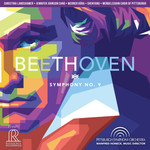|
Back
02/09/2021
Ludwig van Beethoven: Symphony n° 9 in D minor, opus 125
Christina Landshamer (soprano), Jennifer Johnson Cano (mezzo-soprano), Werner Güra (tenor), Shenyang (bass-baritone), Mendelssohn Choir of Pittsburgh, Matthew Mehaffey (choral director), Robyn Bollinger (guest concertmaster), Pittsburgh Symphony Orchestra, Manfred Honeck (music director)
Live recording: Heinz Hall for the Performing Arts, Pittsburgh, Pennsylvania (June 6-9, 2019) – 62’08
Reference Recordings FR-741SACD (Distributed by Naxos of America) – Booklet in English [Ode to Joy lyrics in English and German]

   
Manfred Honeck and the Pittsburgh Symphony Orchestra have released a remarkable new reading of one of the most venerated classics of the Western canon, Beethoven’s Ninth Symphony in D minor, opus 125. Honeck’s vision of this work is impressive for its respect for the instructions of the composer and its dynamic sense of unfolding from the first barely audible rumblings in the bass to the final bacchanalian epiphany.
This recording is one instance in which the liner notes about the symphony, written by Honeck himself, make a substantial contribution to one’s understanding of the work and of the choices conductors must make when working with a score so revered.
What struck me most about this beautifully produced album was the conductor’s confidence in selecting tempi, dynamics and effects that enhance Beethoven’s directions without detracting from them. In Honeck’s own words, take this example regarding the “funeral march” at the end of the first movement: “Here, I reduce the tempo and pay particular attention to the wave-like secondary figures in the strings. I ask for a kind of tremolo that produces an almost gruesome, somber effect. I also direct the strings to play ponticello (on the bridge), thus producing an icy and rigid sound.” These effects intensify but do not contravene what we may suppose are the composer’s intentions.
Few listeners would notice effects like these on the first hearing of this recording. In another example from the scherzo (second movement), Honeck describes how he minimizes monotony while adding substance to the Trio theme which is repeated four times by two horns: “...I ask that each of these four repetitions sound differently, each one diminishing, as if they are getting more and more distant.”
Thanks to these “conductor’s notes”, we do not have to lament that the Adagio molto e cantabile (third movement) is a bit slow for our taste. Honeck explains that Romantics like it slow, Classicists prefer it a bit quicker. There’s no right or wrong, even though that ominous metronome reading of “quarter note= 60”—one beat per second—stares out from the score into the conductor’s eye.
In one case, however, Honeck’s notes do not sync with this listener’s experience. The conductor suggests that the opening of the fourth and final movement should convey the utmost sense of chaos and brutality. However, I found the orchestra’s presentation of the famous crashing chord which begins this section to be rather tame. A truly outrageous expression of this chord, jarring even by 21st century standards, would be a fine way to wake up an audience and launch into the transformative power of the Ode to Joy.
Of course, the fourth movement increasingly stands on its own as an international cry for peace, unity and tolerance, as well as a musical statement without peer. Here the orchestra is joined by the Mendelssohn Choir of Pittsburgh under Matthew Mehaffey and a quartet of distinguished soloists: Christina Landshamer, soprano; Jennifer Johnson Cano, mezzo-soprano; Werner Güra, tenor; and Shenyang, bass-baritone. How delightful was the chorus’s articulation of “Brüder” (“Brother”), warm and loving on the first syllable, and on the second, as wispy and evanescent as a cloud.
As orchestral and choral forces sweep together to meet in this uplifting paean to equality, time stops and all our cares are suspended. Honeck goes one step further, bringing his personal touches within the flexible borders set by the composer. The entrance of the main theme in celli and basses has to be the softest I’ve ever heard, while the tenor and chorus section could win laurels as one of the fastest on record. Yet, these extremes contributed to a unique, intensely energized performance of a composition which is very familiar and often played. The quartet displayed the rare ability to blend as harmoniously as waves at sea and yet showcase the best of each singer’s voice without diminishing the others. Shenyang’s authoritative bass-baritone rang out with classical balance and romantic conviction from the first “O Freunde” to his role as an equal partner in the quartet.
The final moments for orchestra alone—ecstatic and epiphanal—received their due as Honek and the Pittsburgh Symphony Orchestra concluded a mesmerizing performance of a work that challenges each of us to stand up for humanity’s highest ideals and rewards us with some of the most sublime music.
It is our honor and pleasure to hear.
Linda Holt
|